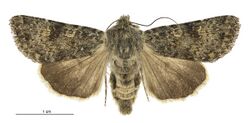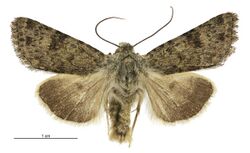Biology:Aletia dentata
| Aletia dentata | |
|---|---|

| |
| Female | |

| |
| Male | |
| Scientific classification | |
| Kingdom: | |
| Phylum: | |
| Class: | |
| Order: | |
| Family: | |
| Subfamily: | |
| Genus: | |
| Species: | A. dentata
|
| Binomial name | |
| Aletia dentata Philpott, 1923[1]
| |
| Synonyms | |
| |
Aletia dentata is a moth in the family Noctuidae. It is endemic to New Zealand.
Taxonomy
The species was first described by Alfred Philpott in 1923.[2] George Hudson in The Moths and Butterflies of New Zealand treated A. dentata as a synonym of Aletia cuneata.[3] Philpott argued against this. Philpott was of the opinion that A. dentata was a separate species as it was darker and smaller than A. cuneata. However he felt unable to confirm this through genitalia examination as no male specimens were available at that time.[4]
The genus level classification of New Zealand endemic moths within the genus Aletia is regarded as unsatisfactory and is under revision.[5] It is likely that this species will be removed from the genus Aletia and be placed within one of the following genera: Physetica, Graphania, Tmetolophota or Ichneutica.[5] As such the species is also known as Aletia (s.l.) dentata.[1] In 2019 Robert J. B. Hoare published a paper in which he undertook a major review of New Zealand noctuids. Hoare, having inspected the holotype specimen of this species, placed it within the genus Ichneutica and synonymised it with Ichneutica cuneata.[6]
Description
Philpott reported that the species had a 34-36mm wingspan.[2] He described the species as being similar to Aletia cuneata but distinguishable as A. dentata has darker colouring and ochreous cilia on its hind wings.[2]
Distribution
A. dentata was discovered by J. G. Myers at Tongariro, in the North Island of New Zealand.[2] Myers observed the species resting on rocks during the day as well as deceased specimens within a tramping hut.[2]
Ecology and habitat
Adults can be active during the day and frequent montane and alpine areas.[2]
References
- ↑ 1.0 1.1 "Aletia dentata Philpott, 1923". Landcare Research New Zealand Ltd. http://www.nzor.org.nz/names/dbef1e87-08f4-4033-946f-7623a947baa8.
- ↑ 2.0 2.1 2.2 2.3 2.4 2.5 Philpott, Alfred (1923). "Notes and descriptions of New Zealand Lepidoptera." (in en). Transactions and Proceedings of the New Zealand Institute 54: 148–154. https://biodiversitylibrary.org/page/33596229.
- ↑ Hudson, G. V. (1928). The Butterflies and Moths of New Zealand. Wellington: Ferguson & Osborn Ltd.. pp. 56–57. http://www.bugz.org.nz/WebForms/ResultDetails.aspx?CurrentDoc=C7E94865-492F-45DA-9777-CC8E1E8B1438&back=true&NewDoc=true&searchType=1&SearchString=G.V.+Hudson.
- ↑ Philpott, Alfred (1928). "Notes and descriptions of New Zealand Lepidoptera.". Transactions and Proceedings of the Royal Society of New Zealand 59: 481–490. http://rsnz.natlib.govt.nz/volume/rsnz_59/rsnz_59_03_004800.pdf. Retrieved 20 December 2017.
- ↑ 5.0 5.1 Hoare, R.J.B.; Rhode, B.E.; Emmerson, A.W. (March 2012). "Larger moths of New Zealand: Image gallery and online guide." (in en). Landcare Research New Zealand Ltd. https://www.landcareresearch.co.nz/resources/identification/animals/large-moths/notes-on-families-and-subfamilies-of-larger-moths-included-in-this-guide.
- ↑ Hoare, Robert J. B. (2019-12-09). "Noctuinae (Insecta: Lepidoptera: Noctuidae) part 2: Nivetica, Ichneutica". Fauna of New Zealand 80: 1–455. doi:10.7931/J2/FNZ.80. https://www.wikidata.org/wiki/Q94481265.
External links
Wikidata ☰ Q35786700 entry

